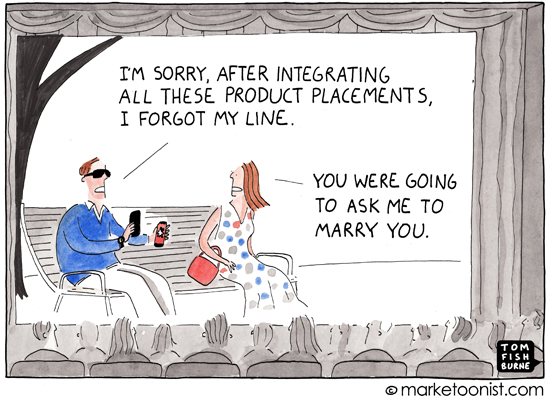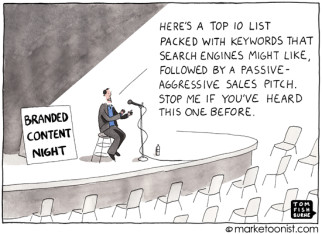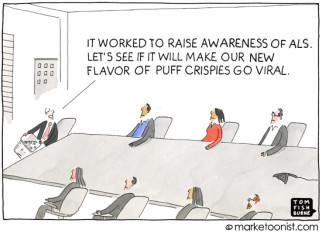Product placement has been around since the early days of entertainment, but it feels like we’re in an awkward adolescent period, weird growth spurts and all. As the entire nature of entertainment shifts and viewers can more easily tune out commercial breaks, marketers are leaping more than ever into the shows themselves.
Sometimes the results are really obnoxious, like this Bones episode where the characters literally pause a murder investigation to marvel at the parking feature of their Toyota.
In other cases, the brands can help add to the story line. There’s a good Adweek article last week on how reality shows like RuPaul’s Drag Race integrated Las Vegas Convention & Visitors Authority and Absolut Vodka.
As RuPaul put it, “The integrations allow us to advertise things in a way that’s sort of a soft sell. We do it in a way that’s clever, that doesn’t really offend the intelligence of the viewer. We have fun with it in a way that we know what we’re doing, they know what we’re doing—and we make it an adventure.”
When I worked on the Haagen-Dazs brand 10 years ago, we dabbled in product placement and product integration. We had a product placement retainer to proactively place ice cream containers in TV shows and movies. Our product placement agency used an elaborate media calculation for the value of those impressions: length of time on screen, how integral the product was to the scene, how much of the logo you could see, etc. It got to be pretty ridiculous. I remember they put a quantified media value against a split-second cut of Cameron Diaz opening a freezer, and if you paused the movie, you could briefly see the burgundy package color of a Haagen-Dazs pint.
But then we had a chance to pitch a reality show to the Food Network to create the next Haagen-Dazs ice cream flavor. We put together a whole contest with video submissions from contestants, flew the finalists to our R&D lab to make flavors by hand, and had panels of judges narrow down the winning flavor, which we launched as our next flavor. The Food Network liked the idea so much, they expanded our pitch from a one-hour to a two-hour special, and they didn’t charge Haagen-Dazs anything because they saw it as a show, not an infomercial. They ran the final show over 10 times and it had a huge impact on the brand.
I remember in the midst of filming that my marketing instincts sometimes got in the way of telling the story. We had marketing signage with huge scoops of ice cream with our marketing tagline that I kept trying to drag into the background of the shots. At one point, the producer pulled me aside and told me I had to know when to stop marketing.
Storytelling is all the rage, but marketers are not naturally great at storytelling. Sometimes we have to learn when to stop marketing.
It will be interesting to watch how product placement evolves. I’d love to hear your thoughts.
(Marketoonist Monday: I’m giving away a signed cartoon print. Just share an insightful comment to this week’s post by 5:00 PST on Monday. Thanks!)



Mads Gorm Larsen says
Product placmement, branded content, native advertising and advertorials are all crossbreds between content and advertisements. A crossbreed can create offspring that has the best traits of both parents, but I have yet to find examples of a mix of content and advertisements, that is not inferior quality to the purebreds of advertising or content.
A says
I find the whole native advertising, product placement trend fascinating. I feel as though it will “boom” just like having to be on digital or social media a few years back. Your media agencies will start telling you that if you arent doing it your’e not in the game.
My only worry is that by this form of communication being the next big “thing” we start to erode the trust of our consumers.
John Brooker says
Tom, I actually found the Bones example better than many placements. At least they got a gag out of it (“Does it solve murders?”), although they should have ended it there and not had her lame line at the end.
Nanc says
Two things popped to mind when I saw this excellent cartoon:
1. The show Chuck, which embraced the Subway product placement, especially after the fans rallied to get an additional season of the show. The writers and actors went all out to sell the obvious product placement but kept the references in character and made it funny–it fit the story.
2. The NCIS episode Witch Hunt, where Gibbs stomps the Roomba. The entire set up of that little scene absolutely fit the story and moved the action forward–not an easy thing to do.
Product placement needs to add something to the story or viewers learn to tune it out.
Tracy Carlson says
It’s easy to get tangled up in the leaves and twigs and miss the forest completely, which is to make a distinctive, memorable impression on the audience. Ideally it’s a positive impact. But here it’s worth reflecting on the larger picture.
Consider Albuquerque, NM as seen in “Breaking Bad.” It’s not exactly a portrayal that would have the local Chamber of Commerce doing backflips for joy over the city’s positive image in that show. Yet the city is reaping a huge benefit in the form of enhanced awareness and tourism. Just Google “Breaking Bad Albuquerque” and you get pages of information on tours, local tie-ins, and more. An outlier, perhaps, but worth remembering before trying to micromanage brand placements to be all sunshine and tidiness.
Connie says
Product placement is so tricky. Its done best when it fits the story, as others have mentioned. The car companies seem to do it best, with cars seeming to fit right into the action in Transformers and Warm Bodies easily. And one of the funniest product placements of all time is Twinkies in Zombieland LOL, with one of the main characters on a quest to find them due to their mythical lack of expiration date.
‘Course, there’s always some bad ones too. The people who did the last Avicii music video for “Wake Me Up” really went over the top with the blatant Windows Phone and Ralph Lauren product placements. The reason it’s bad of course is that it barely fits the storyline (and the Ralph Lauren seems especially out of place in a story about immigrants making their way in the US).
Sean says
“Storytelling is all the rage” is itself a brazenly tone-deaf marketing viewpoint. Storytelling has existed long before there were products to market and will continue to exist long after. There is room for brand and product in stories (and indeed in any media in which stories are told; I was particularly tickled at one point by real web-fed product posters showing up in the dilapidated frames and billboards of a dystopian-future-city video game environment). But unless the stories retain control and the brand serves only to passively increase the specificity and realism of a story element that would be there anyway, it’s going to stick out as advertising. As with any other media, the ad and the advertiser are a guest in the consumer’s life, and in the case of stories, also in the author’s. If a guest tries to control their host’s behavior, they probably won’t be invited back; if the guest helps out and adds value, everyone will have a better experience.
lina says
Tell me about it! I am working on a project, which is all about storytelling. Literally. I am talking about an app for children ,which is telling them fairy tales and fables.
One simply cannot advertise Cinderella’s story.
Anyway,product placement, delivered in a funny way, which makes me grin immediately and applaud in front of the screen, is the only type of PP. It is like a short anecdote you didn’t expect. (Some great examples in the last season of Two and a Half Men.) The rest is annoying commercials you wish you never saw. Thanks!
Tim says
Maybe you could get a product placement fee for the Polycom speakerphones in your boardroom cartoons 😉
The oddest product placement phenomena I’ve seen recently is where private individuals compose their social media updates as if they’re paid placements. I guess that’s a powerful indicator that the marketing is effective and viral.